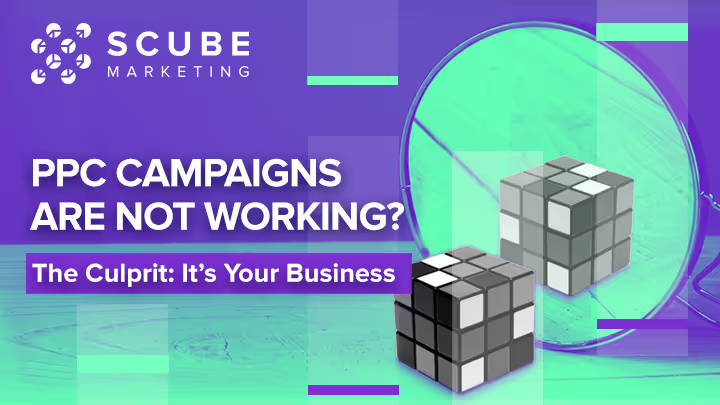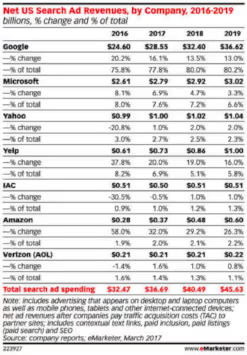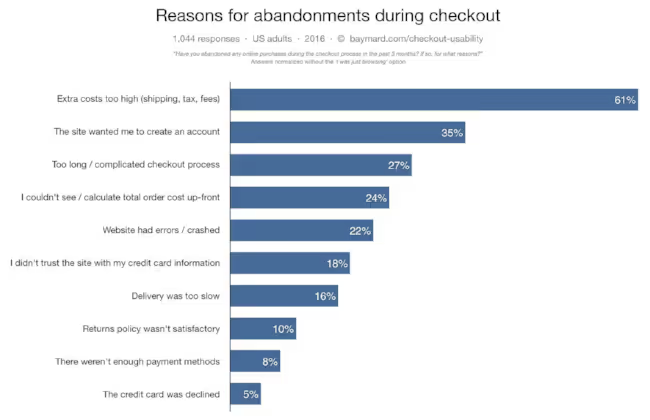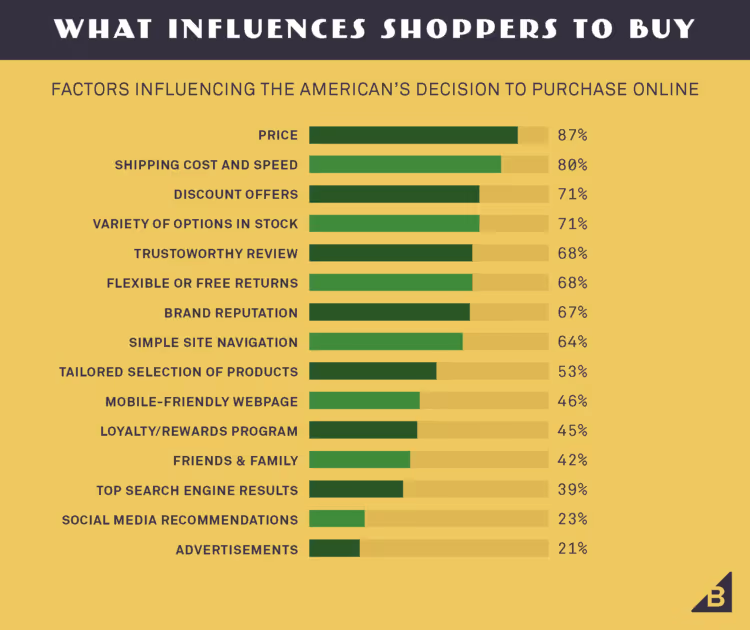
This is the first in a 4-part series covering our BASE methodology for improving e-commerce PPC Program ROI.
PPC is getting harder, more competitive, and more difficult to implement. It’s fast becoming difficult to achieve healthy ROI by relying on PPC campaigns exclusively.
Why is this?
It’s easy to see all of that, throw in the towel, and think PPC is all but dead. It’s easy to get scared while the big dogs at Amazon eat your lunch.
Still, we know that Adwords and Bing Ads are very powerful marketing tools. The reasons are the same as they ever were:

US Search Ad Revenues 2016-2019 (via eMarketer)
There are drawbacks, however. As platforms, they’re not easy to manage, and require long ramp up periods. It’s here where so many businesses falter and withdraw from the fight entirely.
You shouldn’t. By all accounts, Google, Amazon, and the other established players at the table still have all the chips in the casino to play with, and they’re not excusing themselves anytime soon. According to Drivingsales, “overall search spending in the U.S. will increase 24 percent over the next three years, from $36.69 billion in 2017 to $45.63 billion in 2019.”
The players aren’t going to change. The game is.
Their ad platforms are positioned to become stronger with time, and the competition will skyrocket accordingly.
The forces exerted upon us by the external market are constants. Call it a cost of doing business in this industry. Rise above it. Forget about external factors.
Let’s instead focus on internal factors. In other words, controlling what you can control.
Why’s it so important to focus primarily on things you can control?
A lot of factors come into play (obviously) when it comes to thriving in the ever-changing landscape of online advertising. There are a number of external influences, but our focus is, and must be, on internal (or controllable) influences.
We organized the most relevant (and controllable) variables, and we call it our BASE methodology. BASE is comprised of the following variables:
Each variable is relevant to the others, and each requires a deal of explanation as to how they impact your overall efficacy and ROI. Today, we’re focusing (primarily) on internal business mistakes, and how to fix them.
Let’s analyze three key mistakes advertisers everywhere, including you, may be making.
When an idea’s a hit, it becomes everyone’s hit. Apple had the iPod, but everyone started releasing MP3 players chocked full of the same features immediately afterwards. Competition is inherent. Don’t fear it, though. Competition is beautiful, even when it’s your turn to stare it in the face.
More Options For Consumers (via Giphy)
If you don’t work harder to compete, your conversion rate will go down, and your ROI will go down with it.
To stand out, you need a clear value proposition. A value proposition that buyers care about, and one that clearly answers the following question:
“Why should I do business with you?”
Think about it. That’s not just some bullshit corporate jargon like “we have the best product selection, lowest prices, and the best customer service!” If yours is similar, you need to go back to the whiteboard and really think.
Your value proposition needs to be specific, and it needs to resonate with buyers. Of course, ideas are only half the battle -- you need to execute on them.
Let’s look at an Amazon example. They changed the online shopping landscape, buyer behavior, and grew into a juggernaut. Cesare R. Mainardi and Paul Leinwand, the authors of Strategy That Works, explained Amazon’s value proposition:
“Amazon is a super-aggregator of vendors and customers, giving people a compelling, one-stop online shopping experience with easy access to products, information, and friction-free delivery.
Today, it’s simply easier to shop with Amazon than it is to deal with unknown vendors. They were able to position themselves as the default option for the bulk of online shoppers.
Let’s take a look at how poor value proposition really affects your ROI. Take this popular statistic, for example: shopping cart abandonment rate. As of today, it’s 69.23%, according to Baymard.
If you look at the reasons why carts were abandoned, you can clearly see how one might solve the value proposition problem. See below:

Reasons for Checkout Abandonment (via Baymard)
8 out of 10 online shoppers avoid retailers after a bad returns experience.
Think of the people who are in business with you. Continually improving your terms and communicating your value to those people will allow you to start improving your PPC campaign performance.
Baymard reports: “E-commerce sites can gain a 35.26% increase in conversion rate though better checkout design.”
Many factors affect the buyer’s decision to purchase online. Tracey Wallace of BigCommerce compiled a list of those factors, which names shipping costs, speed, and brand reputation as big influencers.

Influencing Factors for Purchasing Online (via BigCommerce)
Here’s what you can do to start improving right away:
Implement a Free-Shipping Policy (Hear Us Out!)
Our managing partner, Diana Bukevicius, says “it’s scarcely profitable to offer free shipping.”
It’s difficult, but not impossible. But a quick look at the numbers tells us this is the direction you need to look if you’re going to thrive.
Diana’s outlined some of the specific methods you can use to make free shipping a part of the offering. Free shipping is not easy to implement, and it could take some trial and error.
But it’s essential to doing business in the modern age.
It’s a huge part of Amazon’s client acquisition strategy, and it’s how they gained the attention of online shoppers everywhere.
Diana recommends (among other things) utilizing the many benefits of flat shipping to get your feet wet with free shipping.
Flat shipping means relying on predetermined rates for packages based on their dimensions. Companies like UPS and FedEx offer these rates competitively. A flat shipping model allows a company to transform its variable costs into static costs, which translates to more effective bookkeeping, planning, and of course -- more profit.
It also allows retailers to include small, free “goodies” with shipments. Companies like Johnny Cupcakes are well-known for the practice, and their users have tagged the company on social media countless times to thank them for surprise gifts. That’s a great exposure, and it’s a great rapport to have with the buyer. An all-around slam dunk for the company.

Johnny Cupcakes (via Instagram)
These offerings don’t have to be fancy. Stickers, gum, a brochure -- these are all good for building a relationship with customers and building brand recognition.
Sticker shock is a buzzkill for online shoppers. Anything you can do to keep your customers in high spirits throughout the order and order fulfilment process is the right thing to do.
Implement a Free-Return Policy
A free-return policy is another winning strategy that helps online retailers cover their bases. The reason is this:
Without a brick and mortar store, your customers are interacting with you using the internet exclusively.
That means there’s no testing an item out before ordering it. When shoppers buy something for themselves or for someone else as a gift, as is the case with any purchase, those items may need to be returned in the future.
Helping those customers by shouldering the cost of shipping on their returns is monumental.
Consider the reasons. If a customer is dissatisfied with a product, will it seem fair to them if they have to pay more money toward the product? Absolutely not.
Many retailers know this, and do accommodate their customers in these situations. L.L. Bean is a great example.

L.L. Bean Return Policy (via L.L. Bean)
The problem is that many retailers don’t communicate that willingness to help effectively. Imagine how much business you could drum up by assuring customers, particularly around the holidays, that it’s free to return any items? This policy dominates when it comes to gift-giving, where there are a lot of returns.
I have some other thoughts on capitalizing on return policies. Preventing returns in the first place is as important (or more) than offering free shipping on them. It’s better to be proactive than reactive, and it’s a good idea to try and prevent as many returns as possible. Don’t forget -- at the end of the day, a return almost always represents some sort of dissatisfaction.
According to Mark Hayes at Shopify, there are a few things to make note of that have a proven impact on preventing returns.
Implement Buyer Education Program
Sometimes, the customer isn’t always right. In these cases, accommodating them anyway is usually the best course of action. Still, as is the case with the return policy, it’s better to be proactive than reactive. Many companies are offering companion literature or media along with their products geared toward helping consumers master those products.
Be Proactive vs. Reactive (via Giphy)
This allows your company to cut back on both returns and unsatisfied customers (and the potential bad publicity that comes with that). Make educational resources available, such as how-to’s and articles on how your customers can best utilize the product they purchased from you.
Kurt Elster, e-commerce consultant and Shopify expert, suggests online retailers “provide live chat to answer questions, personalized follow-up, and exclusive educational content to your customers.”
A live chat program tells your customers that you’re standing by, ready and waiting, to help them out with any issues they may have. They’re much more likely to keep their products, if they feel they’ve gotten decent help in maintaining and using the products properly.
Repair Clinic, an online retailer specializing in replacement parts, makes available to their customers an online library full of educational videos. These videos instill a sense of confidence in their customers, and teaches them the best ways to use the company’s products. In a word, it keeps the products in the customer’s hands.
The company even makes money where there normally would be a loss -- they sell repair tools the customers may need after picking up some DIY skills.

DIY Education (via RepairClinic)
This is an excellent method of demonstrating your brand’s value proposition.
How important is that? Dale Traxler at Practical Ecommerce states it plainly: “your value proposition is the entire reason consumers buy your products or services.”
Lacking an effective value proposition is a key mistake, but there are others.
According to Jaime Brugueras, VP of Customer Success at Networked Insights, companies are calculating ROI based on one purchase, not Customer Lifetime Value (CLV), which he says is one of the most common mistakes e-commerce companies are making.
There are two huge problems with calculating ROI that way:
Dig deeper before declaring your campaign CPA too high to allow for effective customer acquisition. The higher your CLV, the more room you have to play around with methods of acquiring new customers. Avinash Kaushik agrees: “I'm going to suggest that maybe you should be paying significantly more money for the right customers.”
You need to calculate your CLV. It’s that simple.
Here’s the formula:
CLV = T x AOV x AGM x ALT
Where:
T = Average monthly transactions
AOV = Average order value
ALT = Average Customer Lifespan (in months)
AGM = Average gross margin
You might think it’s a little much, but we discussed in another piece the many reasons you’re simply underprepared without having good, hard data at your disposal.
Let’s look at how Starbucks uses this calculation to visualize their customer base. Starbucks isn’t thinking of how best to sell their frappuccinos for five bucks a piece -- they’re focused more on keeping their customers loyal so they can generate $14,099 over the lifetime of a given customer. This calculation transforms the way Starbucks views their marketing efforts.
Starbucks (via Giphy)
Kevin Donnelly at Shopify organizes customers into value tiers based on three factors that will also be a part of any healthy CLV calculations: recency, frequency, and monetary value.
Identifying these metrics is critical in properly calculating the value of your customer base.
Once you know your CLV, it’s time to work on increasing it. The bigger it is, the more profit you can generate per customer, and the more aggressive you can be with you customer acquisition strategy.
CLV and a customer-first outlook are interrelated to each other. If you don’t have a customer-centric culture, you can never know what your customers want, and as a result, you can’t offer it to them. That makes increasing your CLV an uphill battle.
Top marketing teams know how important it is to stay committed to the customer journey. In fact, according to Salesforce, 65% of marketers agree: the more a marketer stays committed to the customer journey as part of their overall business strategy, the better they’ll perform as marketers.

Areas Affecting CLV (via Econsultancy)
Increasing your CLV is important, but there’s no instruction manual for it. It’s not a zero-sum game, unfortunately. There is some prevailing wisdom on boosting CLV, though.
It’s as I said -- having a particular focus on customer satisfaction and retention is critical. Understanding your customers and determining their true value isn’t supplementary, it’s necessary. Take another high-powered business guru’s word for it:
“The most effective marketing strategies are driven by a customer-centric culture. A customer-centric organization is where every process starts and ends with customer success in mind.
— Jill Rowley
Alex over at Retently shows us that retaining existing customers is more effective than earning new ones when it comes to generating revenue.
Obviously, increasing CLV is paramount. To increase CLV, focus on the following:
These variables go back to the CLV calculation.

CLV Variables You Need To Increase
This isn't as tricky as it sounds. I’m not advocating you reach out and nudge your customers in an email. "Can you guys dig a little deeper on your next purchase, please?" probably won't fly so well as a PR strategy.
Here's the thing. You can encourage your shoppers to spend more using a few tricks you can find up any keen marketer's sleeve.
Let's examine an example or two.
Increasing Average Order Value by Getting Customers to Spend More
Two common ways of increasing the average order value are cross-selling and upselling complementary products.
One of the tricks is the psychology of pricing these products.
English speakers read from left to right, and that's how we prioritize and sort information as a result. Ever wonder why everything seems to have $0.99 tacked onto it? It's a function of human psychology.
How comforting? Very. It's so effective as a marketing tactic that it's become universally adopted by retailers all over the world.
It doesn't have to be a dollar, either. Simply dropping the price of an item by a penny does the trick, too. If something's $80, it'll sell less than the same item priced at $79.99 by a long shot.
If you really want to geek out on the pricing, check out Nick Kolenda’s the video on pricing strategy:

Pricing Strategy (via Nick Kolenda)
Increasing The Purchase Frequency and Customer Lifespan
To keep em' coming back and purchase more, look no further than a good old-fashioned newsletter and Facebook Custom Audience campaigns:
Mike Bal, social media director at Single Grain, notes that 25% to 40% of the total revenues of the most stable businesses in the SumAll network come from returning customers.
Focusing on both of these initiatives will allow you to increase revenue, especially over the long term.
It’s clear that external influences are hardly worth worrying about. There’s so much more to focus on in our own backyards that have a more realistic and practical effect on ROI.
I’ve covered a lot of ground today, but bear in mind that we’re examining these metrics under several different lenses. Everything in this article, in respect to the BASE methodology, is a part of the “B” (for “business”). There’s a lot more to learn.
Once you isolate and fix the internal factors we looked at today, you can look at external factors. Until then, you have a lot of work to do. Results don’t fall from the sky. They have to be earned.
Do you have any questions, suggestions, or comments about customer lifetime value, value propositions, or calculating ROI? We’d love to hear about it!